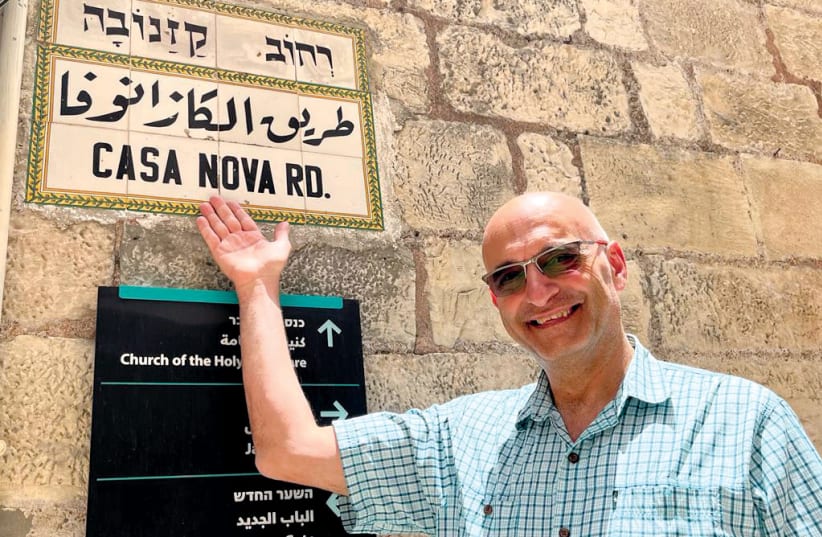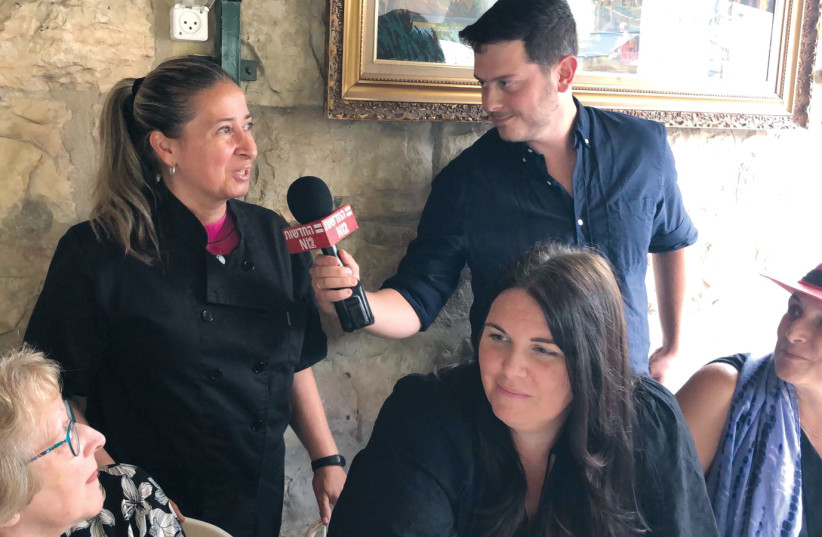Rich in history, rooted in the Bible, famous for conflict, divided along ethnic and religious lines and bursting at the seams with housing and traffic, the holy city is encapsulated in an ongoing identity crisis of then versus now.
Jerusalem today is suspended between expansion and preservation – struggling to maintain its past while also planning its future. Artifacts dating back thousands of years countered by roads ripped up for the construction of a light rail. The Old City skyline interrupted by the odd 5G tower [telecommunications mast].
The digging of the past never stops, yet the building of the future doesn’t either.
Jerusalem: Israel's largest city, with nowhere to build but up
With nearly a million residents, more new immigrants chose to land in Israel’s largest city in 2022. Confined to its own square meterage, this burgeoning metropolis has nowhere to go but up. Literally.
Last year, a record number of 7,300 construction permits were issued in the city, according to a report released this spring by the Jerusalem Institute for Policy Research and the Jerusalem Press Club.
“Jerusalem is prospering and growing, and its businesses and tourism are on the rise,” boasted Mayor Moshe Lion. “Jerusalem ranks first in Israel in terms of urban renewal; and when it comes to housing, the city recorded a threefold increase in new building permits. Its streets are attractive and well tended, and young people from central Israel have been flocking back to the city, joined by hi-tech giants from around the country and the rest of the world who are bringing high-quality employment opportunities to the city.”
What better way to view these strides than through the lens of the past? Some of the first known photographs of Jerusalem – dating back to 1860 – are displayed at Elia Photo Service on the Via Dolorosa in the Old City. Among the historic treasures are the iconic Dome of the Rock before it was covered with gold, and Jaffa Gate without a lineup of taxis.
What can we gather from these photos?
“Everything,” says Elie Kahvedjian.
“People used to get along better. Most of them were poor, they hardly had enough to eat. But relationship wise, people got along much better. Now it’s all politics.”
Kahvedjian’s grandfather Elia, a survivor of the Armenian Genocide, was brought to the Holy Land as a six-year-old orphan. He eventually made his way to Jerusalem, where he took up photography and captured the city’s denizens on film. His son, Kevork, and now his grandson, Elie, have carried on the family business.
Kahvedjian said his grandfather liked to focus on people.
“Now everybody – when they are alone – is looking at their smartphone,” he observes. “There is no character. There is too much photography. Back then, it was more special.”
Although, he concedes, some things never change, “like eating hummus.”
Just ask Ramzi Abu Kamel, the third-generation hummus maker who runs a small eatery with the same recipe in the same spot since 1935. Deep in the Christian Quarter, the Abu Kamels have whipped up chickpea paste under three different mandates and served an array of customers from British soldiers nearly a century ago to groups of Israeli and foreign tourists on any given Shabbat.
Like his grandfather, Abu Kamel serves “everything,” at least on Saturdays, including makloubeh, kebab and a variety of salads, with a seating capacity of more than 50 diners at a time. His father kept it simple: hummus, falafel and only four tables.
“In Jerusalem, all the hummus is good,” Abu Kamel says, simultaneously hat tipping his Old City competitors while maligning hummus anywhere outside its walls.
But even an ancient city can learn new tricks. The street within New Gate was a wreck of unwelcoming, upturned cement. Now, after a $3 million municipal investment, the area was reopened in 2019 as a trendy bar and restaurant scene that oozes cool.
Also relatively new is the Mesila, the network of green trails and parks built along the former train tracks connecting past to present. Perhaps that impacted the sports scene: Whereas few Jerusalemites would be caught dead jogging in the late 1990s, the city has hosted an annual full 42K since 2011, a run infamously considered the world’s toughest city marathon.
The advent of the running scene also brought a new fixture: the dancing man – Mel Kline – who grooves to the beat of his own headphones, drawing smiles, thumbs-ups and even fellow dancers as joggers and walkers pass by.
“I listen to music that I like and dance to it, and I have space out in the fresh air which is pleasant,” he says. The responses he draws are a bonus.
Though Kline, who started dancing only in his sixties, boogies for his own health, he now has a following. Kline once gathered a dancing group in the Mahaneh Yehuda market, the shuk – perhaps the city’s most prominent example of recent gentrification. The down and dirty market where produce was cheap and the hawkers surly, ceded half its real estate to chichi cafes and chef restaurants in the early 2000s – and never looked back.
Jerusalem’s coffee scene has also undergone a transformation from its former staples of botz (Turkish) and nes (instant) coffee to Italian-inspired cappuccino, the resplendent hafuch, in the last three decades.
And, as progress marches on, tea. Sensing that Jerusalem was ready for another change, Elisheva Levy opened Kumkum Tea House, adding a touch of British class to the city. Three-tiered bone-china cake stands may not have seen the light of day in Jerusalem since the Mandate.
“Tea is definitely an upcoming niche,” Levy says. And for the Anglos making aliyah, people “came from places all over the world ready for tea.”
Levy created a refuge for expat Commonwealthers in Jerusalem to mourn the death of Queen Elizabeth with a live stream of her funeral and then, months later, aired the coronation of King Charles. With British royals buried on the Mount of Olives, Jerusalem isn’t far from Buckingham Palace.
Far from royal is the city’s casual fashion, but personal stylist Jennifer Nataf likes to capture those rare residents who hit upon “style genius” and applaud them on her Jerusalem Street Style accounts on Instagram and Facebook.
With elements similar to Humans of New York or The Satorialist, Nataf’s Jerusalem Street Style features snapshots of the well put-together braving the dusty city streets and defying its monotone fashion plate.
“Jerusalem isn’t typically where you’d come to find style,” Nataf admits, but one ray of light is the increase over the past decade in second-hand boutiques, which indicates “an awareness of sustainability and – sometimes – a desire to search for unique items.”
Past and the present also converge on the street signs in the Old City. In 1966, the Jordanian mayor of Jerusalem commissioned Stepan Karakashian to paint the Old City’s street signs in Arabic and English on ceramic tiles. One year later, the city’s new mayor – Teddy Kollek –commissioned Karakashian to add the street names in Hebrew.
What a difference a war makes.
Hagop Karakashian, Stepan’s son, runs Jerusalem Pottery more than a century after his grandfather came to Jerusalem in 1919 with two other Armenian families. The British had invited the artisans to repair the tiles on the Dome of the Rock. They never got to work on the Muslim shrine, but the ongoing Armenian genocide in Turkey prevented them from returning to Armenia. The three families forged a new industry, and now Jerusalem is the only place in the world where authentic “Armenian pottery” exists.
Imitation being the sincerest form of flattery, the motifs decorate the mass-produced ceramics sold in souvenir shops, and the pottery has became synonymous with Jerusalem. But as the city becomes more cosmopolitan and tourists more discerning, Karakashian is observing an encouraging trend.
“All you hear on the news is automation, AI and hi-tech. But when people come here and see my work in the studio, it’s as low tech as you can get,” says Karakashian, who along with his wife and daughter, hand paint their designs. “Now our job is to bring to the attention of people where that mass-produced product came from. It came from my grandfather’s work.”
The city’s progress is astounding, but in equally confounding ways it hasn’t changed much. It is still very much driven by its people, the characters who make the city tick.
“Some things in Jerusalem changed drastically, but some things never do,” says Elie Kahvedjian. He hearkens back to his father’s words for the best description of the city: “Jerusalem for me is like a beautiful mosaic. It is built of different colors, shapes and structures; if you take one of the pieces out, the picture won’t be complete. All this diversity is what makes Jerusalem special.” ■

